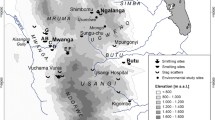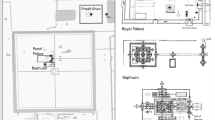Abstract
Iron forging and gunpowder productions were important enterprises in eighteeth-century Mauritius, then known as Île de France. Two sites are tangible testimonies of these industries: one at Balaclava and the other at Pamplemousses. The Powder Mill at Balaclava was part of an arsenal and produced gunpowder from the 1740s to 1774. The Powder Mills in Pamplemousses, commonly known as Moulin à Poudre, was a gunpowder production site between 1775 and 1810, from where the site gained its name. This second site was initially established as an iron forging factory in the 1740s, simultaneously with the gunpowder mill at Balaclava, and then converted into a gunpowder production industrial site in 1775. Since the initiation of systematic archaeological research in 2016, the sites continue to provide critical insight into eighteenth-century enslavement, military history in the Indian Ocean, and local technological advancement. Through a description of the findings, this article illustrates how the local landscape and environment were modified and adapted on a massive scale to accommodate both the industry of iron forging, and, subsequently, gunpowder production.



Source: Archives Nationales d'Outre Mer Aix-en Provence France, 22 DFC 866 1A







Source: B2/A2.2: 1785 Plan de la Manufacture Royale des Poudres de Guerres. Mauritius National Archives







Similar content being viewed by others
References
Allen, R. B. (2022). Plantation Economy and Slavery in the Mascarene Islands (Indian Ocean). Oxford Research Encyclopedias. African History. https://doi.org/10.1093/acrefore/9780190277734.013.902.
Bandaranayake, R. C. (2006). Betwixt Isles: The Story of the Kandyan Prisoners in Mauritius. Vijitha Yapa, Kohuwala.
Benard, A., Maurel, H., Mungur-Medhi, J., Ramasawmy, R., Teelock V., and Teckmun, H. (2018). The Moulin a Poudre Cultural Landscape -History and Archaeology. University of Mauritius Press, Moka.
Bradshaw, T. (1832). Views in the Mauritius, or Isle of France, Drawn from Nature in that Island by T. Bradshaw Esq. Late of His Majesty's Civil Service in that Island. James Carpenter and Son, London.
Bret, P. (1994). Lavoisier à la régie des poudres : Le savant, le financier, l’administrateur et le pédagogue. ffhalshs-00002883f.
Charpentier de Cossigny, J. F. (1807). Recherches physiques et chimiques sur la fabrication de la poudre à canon contenant des observations et des expériences par M. J.-F. Charpentier Cossigny. A. Bailleul, Paris. BNF Cote V-22785.
Chowdhury, A. (2004). Preliminary Survey of Moulin a Poudre for MRC Archaeological Survey of Mauritius. University of Mauritius, Moka.
Gautam, V. (1969). Some aspects of trade relations between United States of America and Mauritius (1780–1789). Proceedings of the Indian History Congress 31: 482-485.
Hoffman, P. T. (2012). Why was it Europeans who conquered the world? Journal of Economic History 72: 601-633.
Lawrence, S., Davies, P., and Turnbull, J. (2016). The archaeology of Anthropocene rivers: water management and landscape change in “Gold Rush” Australia. Antiquity 90: 1348-1362.
Le Roux, T. (2017). The Grenelle Gunpowder Factory explosion: acculturating to industrial hazard in France, 1790–1810. Entre De Recherches Historiques, Paris. Actes D’història De La Ciència I De La Tècnica. Nova Epoca 10: 121–129. http://Revistes.Iec.Cat/Index.Php/Ahct
Mungur-Medhi, J. (2021). Moulin a Poudre Cultural Landscape: Archaeological Research Phase II. National Heritage Fund, Nelson Mandela Centre for African Culture & Centre for Research on Slavery and Indenture, Port Louis.
Mungur-Medhi, J., Ramasawmy, R., Summers, G., Teelock, V., and Teckmun, H. (2017). Moulin a Poudre Cultural Landscape Project. Mauritius Research Council, Port Louis.
Scheler, L. (1973). Lavoisier et la régie des poudres. Revue d'histoire des sciences, pp. 193-222.
Scott, C. L. (2018). Asia in the Gunpowder Revolution. Department of History, The Ohio State University. https://doi.org/10.1093/acrefore/9780190277727.013.18
Stewart, H., Jungkind, K., and Losey, R. (2020). Life on the fence line. Early 20th century life in Ross Acreage. Archaeological Dialogues 27: 57-77.
Timmerhans, C. (1839). Description des divers procèdes de la fabrication de la Poudre à Canon de ses effets dans la bouche a feu et des divers moyens d’Epreuve. A Laneveu Librairie, Paris.
Toussaint, A. (1965). L’Administration Francaise de L’Ile Maurice et ses Archives. National Archives, Port Louis.
Acknowledgments
I seize the opportunity to thank all those who supported and participated in the archaeological expeditions of the two Moulin a Poudre sites at Balaclava and Pamplemousses including volunteers and students. My special gratitude to historian Dr. Vijaya Teelock, who initiated the project and has been the associated historian throughout the project for the site at Pamplemousses. Geoffrey Summers as consultant archaeologist, and Francoise Summers as architect gave their valuable contribution for the site at Pamplemousses during 2016-2017 for which I am highly grateful. A special acknowledgment to the Centre for Research on Slavery and Indenture, the University of Mauritius under whose umbrella the project started in 2015; Mauritius Research Council, who funded the research at Pamplemousses in 2016/2017; Nelson Mandela Centre for African Culture for financial assistance and Our Heritage Foundation for providing research assistants and technical support in the field in 2019/2020. I would like to bring to light and thank Maritime Hotel Ltd, who financed and provided full access and support for the research at Balaclava. I also thank the Mauritius National Archives and National Heritage Fund for their support through these years of fruitful research. My gratitude goes to surveyor Mr. Hembal Teckmun and his team for providing surveying equipment and help in mapping and drawing the modern plans; last but not least, Nipon Medhi for providing full support, field assistance, and producing the photographs and graphics.
Author information
Authors and Affiliations
Corresponding author
Additional information
Publisher's Note
Springer Nature remains neutral with regard to jurisdictional claims in published maps and institutional affiliations.
Rights and permissions
Springer Nature or its licensor (e.g. a society or other partner) holds exclusive rights to this article under a publishing agreement with the author(s) or other rightsholder(s); author self-archiving of the accepted manuscript version of this article is solely governed by the terms of such publishing agreement and applicable law.
About this article
Cite this article
Mungur-Medhi, J. Archaeological Evidence of Landscape and Environmental Changes Due to Iron and Gunpowder Production in Mauritius. Int J Histor Archaeol (2024). https://doi.org/10.1007/s10761-024-00736-8
Accepted:
Published:
DOI: https://doi.org/10.1007/s10761-024-00736-8




